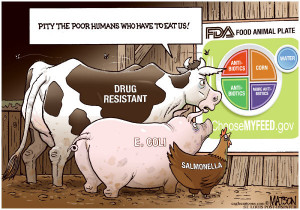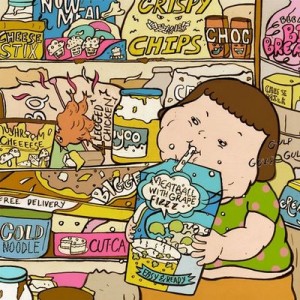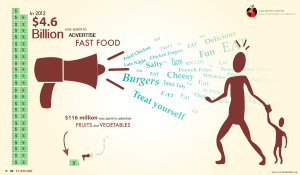In the grainy video of his deposition, the farmer hunches over the desk in front of him. He intermittently rubs his downcast forehead with a weathered hand. Moe Parr’s posture emulates defeat and heartbreak.
In this scene from the documentary, Food Inc., Monsanto lawyers berate the aged and demoralized farmer with a litany of question about bank reports and business relations. This moment serves as an appropriate analogy for the dynamics between farmers and corporations and the control corporations exact over the conventional farming industry.
Over ninety percent of the soybeans in the U.S. contain Monsanto’s patent gene and, in the above scene, the multinational corporation is suing Parr for saving soybean seeds. Even though the seeds Parr is saving are not Monsanto soybeans, Parr is still dragged through the legal process for merely influencing or “inducing” other farmers to save seed. According to the documentary, a team of Monsanto investigators roams the country monitoring and prosecuting farmers for saving seed and violating patent infringement.
“I can remember when the first prohibitions against seed saving came into being,” says Troy Roush, Vice President of American Corn Growers Association, in an interview in the documentary, “Most farmers were just absolutely disgusted with the whole concept. It’s been interesting over the course of 11 years to watch us go from utter contempt for the notion that we can’t save our own seed to acceptance.”
Corporations have a clout and reach so pervasive and powerful that they can destroy a farmer’s life with a set of charges completely detached from truth. Parr was forced to settle out of court because he couldn’t afford his legal bills.
“I am finished,” Parr’s slow country drawl plays over the footage of his interrogation with the lawyers.
For years, debates over food production and regulation in America have drifted into the national conversation. Documentaries, op-eds, studies, articles and books present arguments defending or condemning conventional farming processes and organic alternatives. Critics of conventional farming repeatedly deconstruct the processes and the environment of the industry while highlighting safety oversights, risks of food contamination and the systemic spread of food-related illnesses. The regular outbreaks of E. coli and listeria provide an example of that as they continue to claim headlines and steal lives. But parallel to discussions over the nutritional value and health risks of mass-produced food, the exploitation of the workers and animals involved in the industry is another jarring facet of this matter.
The video footage surfing the internet of baby chicks being thrown into machines or pigs being electrocuted or cows being beaten is often fodder enough to convert people to vegetarianism or convince them to shop at local farmers’ markets. But in addition to the unsightly abuse of animals, these corporations also exploit humans. This is revealed in the working conditions in slaughterhouses, notorious for being physically dangerous and emotionally exhausting. According to the food justice organization, Food Empowerment Project, of the 500,000 people working in these meat-processing facilities, many are undocumented workers or people of color from low-income communities. Most of these workers are “at-will” employees, meaning the threat of immediately termination from a supervisor is always present.
“Supervisors use a variety of intimidation tactics to suppress workers’ concerns and make it clear that other people are always available to replace them. As a result, workers are conditioned to accept a hazardous and demeaning work environment if they want to remain employed,” the Food Empowerment Project website reads.
Marion Nestle mentions in her book, “Food Politics,” that large corporations often employ illegal immigrants specifically because they are unlikely to vie for better working conditions or wages. The industry strategically constructs an employee demographic of immigrants, teenagers and other often ignored people groups because they are less likely to know their rights and more willing to endure minimum wages with no benefits or chances for pay raises.
Corruption between corporations and government agencies also makes them involved in establishing the very regulations that are supposed to leash and monitor them. Corporations often determine, or at least influence, the rules and government agencies fall in line. Without real accountability and consequences, these corporations repeatedly prove irresponsible with health and safety measures while solely perseverating on their own profit. They can introduce new methods of production that risk the safety of people and animals, but weld enough money and shady connections to silence pushback.
In the abovementioned documentary, there is a scene where the jolly and portly chicken farmer, Vince Edwards drives the documentarians to his farm. Proud of the production of his poultry, Edwards seems eager to showcase his coups to the camera crew. But his employer, Tyson, steps in before and informs Edwards he is not allowed to show the inner workings of his own farm. Edwards give a sheepish shrug and a toothy grin. He doesn’t know why he can’t. But those are his orders. Moments like this again illustrate the reach and power of these corporations.
While company authorities intimidated Edwards’ enthusiasm to showcase his coups, Carole Morison said she felt compelled to speak on the topic. “I understand why farmers don’t want to talk because the company can do what it wants to do as far as pay goes since they control everything. But it has just gotten to the point that it is not right what is going on,” said the chicken farmer. “This isn’t farming. This is mass production like as assembly line in a factory,” she continued as she toured the documentarians through her coups, expressing disgust at the conditions.
That scene shows bloated chickens pumped up on drugs to fatten them up and to increase profits. Their bulging bodies are deformed with tumors of extra and abnormal fat from the antibiotics. Their spindly legs cannot support their extreme weight so their short lives are mostly sedentary.
Some corporations require that the chickens be kept in huts that are completely enclosed. So in addition to crammed courters and malformed bodies, these animals are also sentenced to a life of pitch black. Morison refused to enclose her open-windowed coup. The film reported that her contract with Perdue was later voided for her actions.
Amid the critiques and negativity though, Blake Hurst heralds conventional farming practices in his article, “Organic Illusions.” In fact, he frames the current conditions as not repressive but as almost liberating for the workforce. With experience and insight as an actual farmer, Hurst harkens back to the olden days emphasizing that conditions today are less physically draining on workers and demand less labor from them.
“Those of us who grew up with a hoe in our hand have absolutely no nostalgia for days gone by,” Hurst remarks, “People love to talk about traditional agriculture, but I’ve noticed that their willingness to embrace the land is often mostly metaphorical.”
Hurst also believes that conventional farming methods serve an even more grandiose purpose for humanity. In a world without the pesticides and slaughterhouses that make farming easier and more efficient, Hurst notes that more people would be sweating and slaving in fields right now. But, now those people are enable to be elsewhere in the world becoming playwrights and philosophers and doctors.
But the reality of the socioeconomics of food industry workers, a collection of mostly disenfranchised laborers working meager wages and often in unsafe conditions, dulls the romanticism which Hurst paints. Although fewer people may be hoeing potato fields right now, many are being exploited and abused by corporations. And while unemployment has almost returned to pre-Great Recession rates, jobs are always welcomed in the States. So Hurst’s lofty argument that contemporary farming liberates more people from the monotony of farm work to find more artist or altruistic endeavors seems to fall flat as well.
In a Consumer Reports article analyzing conventional farming methods and how there is contamination and oversight in that process, some of the potential sicknesses animals can contract were listed. The article reads, “Regulatory loopholes could allow mad cow infection, if present, to make its way into cattle feed; drugs used in chickens could raise human exposure to arsenic or antibiotic-resistant bacteria; farmed fish could harbor PCBs and dioxins.”
This catalog of health risks present to animals (and the humans that consume them) points to these procedures not being the cleanest and healthiest means of farming. These diseases evoke a picture of these animals’ condition as clearly insufficient. No longer does the image of American farming conjure up a scene of healthy animals in green pastures. But now the snapshot of farming equates to hordes of animal bodies, pumped up on drugs or standing in feces or crammed in cages and pens. And although the condition of farmers and workers is different, many argue is just a different manifestation of abuse.
1.) The idea of a “writer’s project” is sort of like a thesis, but more expanded with more exchange and breath. Instead of summing up the writer’s whole collection of work with one statement or idea, the idea of a project tracks the process of communication and thought to encompass the whole idea with its uses and shortcomings. My own “project” is to show examples and moments of abuse and exploitation of farmers, workers and animals. These moments collectively help to inform my “thesis” that corporations are the abusers with unmatched and unrestrained power and influence.
2.) I was actually sick during the day the class completed this workshop. But I found all the charts we made during class to be very helpful in writing my article. I was able to pull detailed and specific information from multiple sources and see how the projects in several sources parallel or contradicted each other. This was extremely helpful when synthesizing my own project. Several themes had been reiterated in different ways and I was able to construct my own narrative from that.
3.) My understanding of synthesis is that is it the understanding of a writer’s project and being able to mesh multiple projects or perspectives together to construct a dominate message or to communicate an idea. I do this is my own piece when I use the different insights from the Food Empowerment Project and Nestle’s book to discuss the injustice of the socioeconomics of farmers and labors. I do this in another way when I pieced together Nestle or Hurst show different opinions about that same topic.
4.) I learned to collect different sources together to prove one concise point that was solidly backed up and convincing.
5.) The main idea started with inspiration. I was so disturbed after watching Food Inc. that I knew I wanted to talk about the human side of the issue. How cruel people are treated. I started with emotion and refine it to be a concise argument. I jotted down in my notebook how jarring the scenes from the documentary were and then I revisited those notes and created the narrative aspect of my article, like the anecdote with Morison and Edwards and Parr.
6.) The way I write in general sort of lacks organization or method. I just sit down and try to become inspired and just kind of feel when the piece is making sense or not. I write and then edit and refine and edit and refine. I think in my first drafts though, my piece was academic and wordy and as I edited I tried to water all that down and make it more conversational. Here is a paragraph from my first draft and then the final version that show this transition: ” Hurst harkens back to the olden days showing that although conditions aren’t ideal now, they might be less physically draining and involved for farmers and workers. He says conventional farming gives time and space to people that would have spent hours in a field to become playwrights and philosophers and doctors. But in her book, “Resisting Food Safety,” Marion Nestle mentions that the food industry hires mostly immigrants and teenagers at meager wages.”
“Amid the critiques and negativity though, Blake Hurst heralds conventional farming practices in his article, “Organic Illusions.” In fact, he frames the current conditions as not repressive but as almost liberating for the workforce. With experience and insight as an actual farmer, Hurst harkens back to the olden days emphasizing that conditions today are less physically draining on workers and demand less labor from them.”
I think in the second example, my point and language are more concise and direct.
7.)In discussing the work conditions of laborers in the industrial farming industry, I used Nestle and another outside source (the Food Empowerment Project website) to show how arduous working conditions in farming are today. But I also included Hurst and his positive outlook on how modern methods of farming actually benefit the workers. I did this to add balance and give two opinions on the matter.
8.) Initially, my lede was dry and wordy. And in the passive voice. The first two sentences in my first draft were: “For years, debates over food production and regulation in America have drifted into the national conversation. Documentaries, op-eds, studies, articles and books have constructed arguments defending or condemning conventional farming processes or organic alternatives.” I tried to be creative, but it was sort of dull and dispassionate. After reading the article in class about ledes, I decided to do something more interesting and something I thought would grip the reader. I got good feedback from my peers during groups edits, so I just revised and used that: In the grainy video of his deposition, the farmer hunches over the desk in front of him. He intermittently rubs his downcast forehead with a weathered hand. Moe Parr’s posture emulates defeat and heartbreak.
In this scene from the documentary, Food Inc., Monsanto lawyers berate the aged and demoralized farmer with a litany of question about bank reports and business relations. This moment serves as an appropriate analogy for the dynamics between farmers and corporations and the control corporations exact over the conventional farming industry.
9.) I would like to improve my writing overall with a more developed vocabulary and concise way of communicating my intent. I want my writing to be fluid and punchy. I don’t just want to provide information, but to provide narrative and evoke emotion. Basically, I want to become a more powerful writer.











